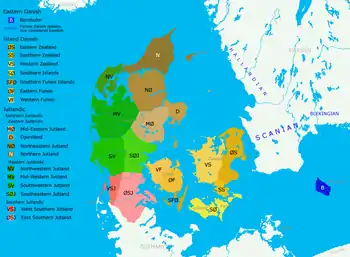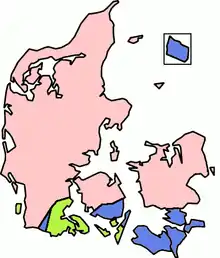Danish dialects
The Danish language has a number of regional and local dialect varieties.[1][2] These can be divided into the traditional dialects, which differ from modern Standard Danish in both phonology and grammar, and the Danish accents, which are local varieties of the Standard language distinguished mostly by pronunciation and local vocabulary colored by traditional dialects. Traditional dialects are now mostly extinct in Denmark, with only the oldest generations still speaking them.

The traditional dialects are generally divided into three main dialectal areas: Jutlandic dialect, Insular Danish and Bornholmish. Bornholmish is the only Eastern Danish dialect spoken in Denmark, since the other Eastern Danish dialects (Skånsk, Blekingsk, Hallændsk) were spoken in areas ceded to Sweden and subsequently assimilated to Standard Swedish. Jutlandic is further divided into Southern Jutlandic and Northern Jutlandic, with Northern Jutlandic subdivided into North Jutlandic and West Jutlandic. Insular Danish is divided into Zealand, Funen, Møn and Lolland-Falster dialect areas - each with addition internal variation.
Stød and tonal accents

The realization of stød has traditionally been one of the most important isoglosses for classifying geographic dialect areas. There are four main regional variants of stød:
- In Southeastern Jutlandic, Southernmost Funen, Southern Langeland and Ærø, there is no stød but rather a form of pitch accent.
- South of a line (Danish: Stødgrænsen "the stød boundary") going through central South Jutland and crossing Southern Funen and central Langeland and north of Lolland-Falster, Møn, Southern Zealand and Bornholm, there is neither stød nor pitch accent.[3]
- In most of Jutland and Zealand, there is stød.
- In Zealandic traditional dialects and regional language, stød is more frequent than in the standard language.[4]
In Zealand, the stød line divides Southern Zealand, without stød, an formerly directly under the Danish crown, from the rest of the island, formerly the property of various noble estates, with stød.[3]
In the dialects with pitch accent, such as the Southern Jutlandic of Als (Synnejysk), stød corresponds to a low level tone, and the non-stød syllable in Standard Danish corresponds to a high rising tone.:[5]
| Word | Rigsdansk | Synnejysk | |
| dag "day" | [daˀ] | [dàw][5] | |
| dage "days" | [daːə] | [dǎw][5] |
On Zealand, some traditional dialects have a phenomenon called short-vowel stød (kortvokalstød): some monosyllabic words with a short vowel and a coda consonant cluster have stød when the definite suffix follows: præst [pʁæst] "priest" but præsten [pʁæˀstn̩] "the priest".[6]
In Western Jutland, a second stød, more like a preconsonantal glottal stop, occurs in addition to the one of Standard Danish.[7] It occurs in different environments, particularly after stressed vowels before final consonant clusters that arise through the elision of final unstressed vowels. For example, the word "to pull", which is /trække/ in Standard Danish, is [tʁæʔk] in Western Jutlandic. Also, the present tense, which is /trækker/ in Standard Danish, is [tʁæʔkə] in Western Jutlandic.[8][9]
References
- "Dialekt.dk". Dialekt.dk. Retrieved 2010-10-02.
- "danske dialekter | Gyldendal - Den Store Danske" (in Danish). Denstoredanske.dk. Retrieved 2013-09-22.
- "Stød". University of Copenhagen, Center for Dialect Studies.
- Ejskjær 1990.
- Jespersen 1906, pp. 127-128.
- Sørensen 2011.
- Basbøll 2005, p. 85.
- Perridon 2009.
- Kortlandt 2010.
Bibliography
- Basbøll, Hans (2005). The Phonology of Danish. Oxford University Press. ISBN 978-0-19-824268-0.CS1 maint: ref=harv (link)
- Ejskjær, I. (1990). "Stød and pitch accents in the Danish dialects". Acta Linguistica Hafniensia. 22 (1): 49–75.CS1 maint: ref=harv (link)
- Kortlandt, F. (2010). "Vestjysk stød again". Amsterdamer Beiträge zur älteren Germanistik. 66 (1): 29–32.CS1 maint: ref=harv (link)
- Perridon, H. (2009). "How old is the vestjysk stød?". Amsterdamer Beiträge zur älteren Germanistik. 65: 5–10.CS1 maint: ref=harv (link)
- Jespersen, O. (1906). Modersmålets fonetik. Schuboth.CS1 maint: ref=harv (link)
- Sørensen, V. (2011). Lyd og prosodi i de klassiske danske dialekter. Peter Skautrup Centret.CS1 maint: ref=harv (link)
